Adding an outdoor dining area is one of the best ways to enjoy the outdoors in your own back yard. Lunch in the sun or dine under stars. Creating an outdoor dining area can be as simple as putting a picnic table in the yard or as complex as building a large outdoor kitchen. Check out our slide show to see a wide range of designs, then read our guide on designing an outdoor dining area below:
-
OUTDOOR DINING AREAS: Amazing contemporary design!
http://gardendesignforliving.com/wp-content/uploads/2011/01/the-patio-garden-landscape-designs-1.jpg
-
OUTDOOR DINING AREAS: This outdoor living area has a beautiful formal look. Notice the formal plantings that match the style of the patio.
http://gardendesignforliving.com/wp-content/uploads/2011/01/rattan-garden-2.jpg
-
OUTDOOR DINING AREAS: Great traditional design
http://gardendesignforliving.com/wp-content/uploads/2011/01/photo3.jpg
-
OUTDOOR DINING AREAS: This open design creates a very social atmosphere
http://gardendesignforliving.com/wp-content/uploads/2011/01/MacDowell-Back-Yard-Pergola.jpg
-
OUTDOOR DINING AREAS: Impressive patio and fireplace!
http://gardendesignforliving.com/wp-content/uploads/2011/01/belgard-fireplace-dining-2.jpg
-
OUTDOOR DINING AREAS: Hot tub, fireplace and dining...this is a complete backyard retreat!
http://gardendesignforliving.com/wp-content/uploads/2011/01/outdoor-dining-area-outdoor-fireplace-1-e1301496960648.jpg
-
OUTDOOR DINING AREAS: The small table and arbor give this patio an intimate feel even though it's very large
http://gardendesignforliving.com/wp-content/uploads/2011/01/fireplace-and-patio-e1301498238114.jpg
-
OUTDOOR DINING AREAS: The fireplace in this space adds some serious drama.
http://gardendesignforliving.com/wp-content/uploads/2011/01/awesome-fireplace-dining.jpg
-
OUTDOOR DINING AREAS: A small, low cost dining area
http://gardendesignforliving.com/wp-content/uploads/2011/01/dddd.jpg
-
OUTDOOR DINING AREAS: Great design for overlooking a view
http://gardendesignforliving.com/wp-content/uploads/2011/01/circular-dining.jpg
-
OUTDOOR DINING AREAS: An open and informal design works well for large gatherings
http://gardendesignforliving.com/wp-content/uploads/2011/01/chestnuthill_fuller3.jpg
-
OUTDOOR DINING AREAS: A small intimate design that won't break the budget
http://gardendesignforliving.com/wp-content/uploads/2011/01/brick_paver_patio_designs_2.jpg
-
OUTDOOR DINING AREAS: This is a great sleek look for intimate gatherings
http://gardendesignforliving.com/wp-content/uploads/2011/01/Garden-Furniture1.jpg
-
OUTDOOR DINING AREAS: This large table will encourage a feeling of closeness even for large groups
http://gardendesignforliving.com/wp-content/uploads/2011/01/big-table-outdoordining1.jpg
-
OUTDOOR DINING AREAS: Small but very elegant. Notice the curved pattern in the patio stones. also notice the columnar shrubs that give a point of interest. Very well done.
http://gardendesignforliving.com/wp-content/uploads/2011/01/small-table-outdoor-dining.jpg
-
OUTDOOR DINING AREAS: Another large patio. The wall gives the dining area a feeling of overlooking the yard.
http://gardendesignforliving.com/wp-content/uploads/2011/01/belgard-fireplace-dining-3.jpg
-
OUTDOOR DINING AREAS: Great use of natural stone to blend the patio into the landscape
http://gardendesignforliving.com/wp-content/uploads/2011/01/brick3.jpg
-
OUTDOOR DINING AREAS: This is great for small gatherings in the evening
http://gardendesignforliving.com/wp-content/uploads/2011/01/Alan-Steiman-Summer-Patio_0.jpg
-
OUTDOOR DINING AREAS: This is a very traditional look that would be great for open, social gatherings.
http://gardendesignforliving.com/wp-content/uploads/2011/01/276760-24513-0.jpg
-
OUTDOOR DINING AREAS: Walls give even a large patio a more intimate feeling.
http://gardendesignforliving.com/wp-content/uploads/2011/01/walled-outdoor-dining.jpeg
-
OUTDOOR DINING AREAS: Great ultra modern look, but always be careful not to contraxst too much with your house design. This style goes best with an ultra modern house.
http://gardendesignforliving.com/wp-content/uploads/2011/01/ultra-modern.jpg
-
OUTDOOR DINING AREAS: This stark look works best in sunny locations.
http://gardendesignforliving.com/wp-content/uploads/2011/01/spanish-outdoor-dining-area.jpg
-
OUTDOOR DINING AREAS: This is the most casual furniture imaginable, but the view says it all. There's a great lesson here...sometimes you don't want to compete with a great view!
http://gardendesignforliving.com/wp-content/uploads/2011/01/simple-dining.jpg
-
OUTDOOR DINING AREAS: The large rocks set a rustic tone allowing for the use of a picnic table. This kind of table wouldn't work well in most areas, but the rustic feel here makes it seem like a natural fit.
http://gardendesignforliving.com/wp-content/uploads/2011/01/rustic-rocks-dining.jpg
-
OUTDOOR DINING AREAS: These stylized plantings create a handsome urban feel. The patio surface and furniture match well and pull the style together.
http://gardendesignforliving.com/wp-content/uploads/2011/01/rooftop.jpg
-
OUTDOOR DINING AREAS: Simple design for a modest budget
http://gardendesignforliving.com/wp-content/uploads/2011/01/51otSBbodzL.outdoor-patio-furniture.jpg
-
OUTDOOR DINING AREAS: This rustic pergola is a great way to shade a sunny dining area. Or create more intimacy in the evening.
http://gardendesignforliving.com/wp-content/uploads/2011/01/poolside-pergola-dining.jpg
-
OUTDOOR DINING AREAS: The repeating theme of the plantings really makes this adining area shine.
http://gardendesignforliving.com/wp-content/uploads/2011/01/pergola-small-outdoor-dining.jpg
-
OUTDOOR DINING AREAS: This is an incredible dining area. It's probably out of range of most budgets, but you can always pick and choose elements from any design you like.
http://gardendesignforliving.com/wp-content/uploads/2011/01/patio-pictures1.jpg
-
OUTDOOR DINING AREAS: Notice the way the grass is allowed to grow between the stones. This look is easy to create and looks amazing.
http://gardendesignforliving.com/wp-content/uploads/2011/01/outside-dining.jpg
-
OUTDOOR DINING AREAS: The roof gives this outdoor room a very unique feel. It focuses attention into the room. Ideal for intimate gatherings.
http://gardendesignforliving.com/wp-content/uploads/2011/01/outdoor-room.jpg
-
OUTDOOR DINING AREAS: A very basic design. If you get this basic, you need to use well designed furntiure because it will draw all the attention!
http://gardendesignforliving.com/wp-content/uploads/2011/01/outdoor_dining.jpg
-
OUTDOOR DINING AREAS: A great example of how closed in spaces create intimacy...especially at night.
http://gardendesignforliving.com/wp-content/uploads/2011/01/outdoor-dining-with-pergola.jpg
-
OUTDOOR DINING AREAS: This is a unique use of lighting. The shaped plantings also add to the mood.
http://gardendesignforliving.com/wp-content/uploads/2011/01/outdoor-dining-with-embedded-lighting-e1301496012111.jpg
-
OUTDOOR DINING AREAS: Fabrics really make this space something special. Not advised for areas that get a lot of rain!
http://gardendesignforliving.com/wp-content/uploads/2011/01/Outdoor-dining-with-curtains.jpg
-
OUTDOOR DINING AREAS: The wall gives a great backdrop to this area making it more intimate.
http://gardendesignforliving.com/wp-content/uploads/2011/01/natural-stone-patio-dining-area.jpg
-
OUTDOOR DINING AREAS: Very modern dining area. Looks great, but be careful. The house style should match if this dining area is anywhere close to the house.
http://gardendesignforliving.com/wp-content/uploads/2011/01/modern-dining-e1301497588269.jpg
-
OUTDOOR DINING AREAS: This room is very simple. The wood gives it a warm feel that's not expensive to replicate.
http://gardendesignforliving.com/wp-content/uploads/2011/01/outdoor-room-after-m-e1301497924825.jpg
-
OUTDOOR DINING AREAS: The use of containers in this dining area gives it a Spanish Colonial feel.
http://gardendesignforliving.com/wp-content/uploads/2011/01/mexican-outdoor-dining.jpg
-
OUTDOOR DINING AREAS: The lodge look. Works well if you actually have a lodge, but don't try this on just any house!
http://gardendesignforliving.com/wp-content/uploads/2011/01/Lodge-outdoor-dining.jpeg
-
OUTDOOR DINING AREAS: The japanese style here is impressive. The floor-level dining is especially interesting.
http://gardendesignforliving.com/wp-content/uploads/2011/01/japanese-outdoor-dining.jpg
-
OUTDOOR DINING AREAS: Very intimate style almost hidden in the garden.
http://gardendesignforliving.com/wp-content/uploads/2011/01/garden-dining-e1301497621509.jpg
-
OUTDOOR DINING AREAS: These curves add interest and make the modest dining area something amazing. Love the natural stone too!
http://gardendesignforliving.com/wp-content/uploads/2011/01/garden-chairs.jpg
-
OUTDOOR DINING AREAS: Perfect blend of garden and dining area. Notice how much more intimate the area feels because of the garden.
http://gardendesignforliving.com/wp-content/uploads/2011/01/garden-dining-area-e1301497649417.jpg
-
OUTDOOR DINING AREAS: This is an interesting stone table with a large patio. Also interesting use of color.
http://gardendesignforliving.com/wp-content/uploads/2011/01/firplace-blue-cushions-e1301497676820.jpg
-
OUTDOOR DINING AREAS: Notice the way this patio needs no border. Very simple and elegant.
http://gardendesignforliving.com/wp-content/uploads/2011/01/dining-with-people-e1301497697820.jpg
-
OUTDOOR DINING AREAS: Firepits can make a dining area more interesting and social.
http://gardendesignforliving.com/wp-content/uploads/2011/01/dining-with-firepit-and-walls.jpg
-
OUTDOOR DINING AREAS: Great example of a small dining area. The plantings do most of the work.
http://gardendesignforliving.com/wp-content/uploads/2011/01/dining-teak-table.jpg
-
OUTDOOR DINING AREAS: Who needs a patio? This dining area looks great right on the grass. But it's not suggested if your dining area will have heavy traffic.
http://gardendesignforliving.com/wp-content/uploads/2011/01/dining-on-grass.jpg
-
OUTDOOR DINING AREAS: Great use of stone to build a dining area without furntiure.
http://gardendesignforliving.com/wp-content/uploads/2011/01/contemporary-outdoor-dining-with-firepit.jpg
-
OUTDOOR DINING AREAS: This is a great example of matching styles between patio surface and furniture. both here are modern and fit well together.
http://gardendesignforliving.com/wp-content/uploads/2011/01/contemporary-dining.jpg
-
OUTDOOR DINING AREAS: Another example of drama created with a large fireplace.
http://gardendesignforliving.com/wp-content/uploads/2011/01/outdoor-room-dining-fireplace-l.jpg
-
OUTDOOR DINING AREAS: Interesting use of outdoor lighting
http://gardendesignforliving.com/wp-content/uploads/2011/01/chinese-dining.jpg
-
OUTDOOR DINING AREAS: A practical, low cost family dining area
http://gardendesignforliving.com/wp-content/uploads/2011/01/dining-by-door.jpg
-
OUTDOOR DINING AREAS: This incredible design creates both intimacy and drama and comes with a high price tag as well
http://gardendesignforliving.com/wp-content/uploads/2011/01/commune-design-patio-with-tile-floor-e1301497758986.jpg
-
OUTDOOR DINING AREAS: Sleek lines. Very contemporary.
http://gardendesignforliving.com/wp-content/uploads/2011/01/poolside-dining-area.jpg
-
OUTDOOR DINING AREAS: Great deck for outdoor dining
http://gardendesignforliving.com/wp-content/uploads/2011/01/great-deck.jpg
-
OUTDOOR DINING AREAS: Pea stone makes a great low cost patio surface
http://gardendesignforliving.com/wp-content/uploads/2011/01/pea-stone-dining.jpg
-
OUTDOOR DINING AREAS: Stamped concrete dining area
http://gardendesignforliving.com/wp-content/uploads/2011/01/stamped-concrete-dining.jpg
Designing an outdoor dining area
Always start with a goal!
Here at Garden Design for Living, we always start the design process by defining a specific goal. Outdoor dining means different things to different people, so before going out and shopping for your dining furniture, start by defining your goal. Ask yourself what do you want from your dining area. Will it be for large gatherings or just for you and your family? Should it be intimate and private or open and social? Will you use it in the daytime or in the evening? Do you want to cook in your dining area or cook indoors and serve outdoors? Will you be entertaining children, families or all adults?
Once you’ve given these questions some thought, you should define your goal and even write it down. Then you can refer to it anytime during your process to make sure your choices are made in the best interest of completing your goal.
Decide on a mood
The mood you create is very important. Think about how you want your dining area to feel. Your design will look very different depending on the mood you want to create. Here are some tips to create the mood you want for different types of gatherings.
Practical dining for your family:

A practical family dining area
If your dining area is just for you and your family, keep it simple. Position your area close to the kitchen door and include an outdoor grill. Make it practical. Have enough space for a guest or two that might drop by.
Intimate dining for small groups:
If you’re looking for intimate gatherings where wine and conversation flow easily among adults, position your dining area away from the house. Don’t include cooking appliances in the dining area, make the cooking and dining two separate experiences. This will enhance the intimacy of the dining area. Use generous landscape lighting and keep the lighting close to the ground. Any lighting that shines down on your dining area from above should be very soft. Another key to creating intimacy is to surround your dining area with either plantings or hardscape like stone walls. Pergolas and outdoor fireplaces (not fire pits!) also add intimacy, but can get expensive. Don’t confuse fireplaces with fire pits. Fire pits tend to create more open and social moods where fireplaces add intimacy.
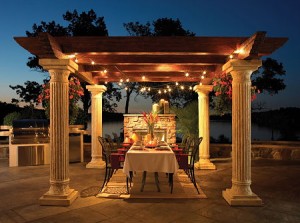
Intimate dining
For a surface, pea stone or natural stone are best, but stamped concrete or pavers can work if you stick to designs that look more like natural stone.
Dining for large social gatherings:
If you want your back yard to be party central, then be sure to create a large space that abuts lots of open lawn (or even better…a pool!). If you’re using a deck, keep your dining area as close to ground level as possible to avoid the need for railings. Patios usually work better that decks for creating fun social spaces. Include lots of cooking appliances in your design. You want the cooking to take place in the same space as dining. If you can afford it, go with a complete outdoor kitchen with a bar.
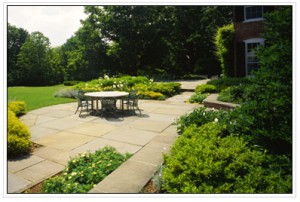
An open design for large gatherings
To create a social mood, you want to avoid going into the house as much as possible. The more you can do outside, the better. If you don’t include an outdoor kitchen, place the dining area as close as possible to the indoor kitchen to make delivering food easier. If you include plantings, stick with low, sturdy shrubs and avoid delicate perennials. Be sure to keep the space open. Don’t close it in with too many plants. Fire pits are also great for creating a social atmosphere. Make sure to leave plenty of room for seating around your fire pit. Use lots of light, flexible furniture. In large gatherings, your guests will move furniture around to suit their needs. Use practical lighting that can really light up the space at night.
Pavers or stamped concrete work well for patios designed for large gatherings.
Choosing the right surface for your dining area:
The surface for your dining area can also make a big difference in how it feels and works to suit your needs. Budget is also a big concern. Landscaping surfaces have a very wide range when it comes to pricing. Let’s look at some options for your dining area landscape surface.
Decks
Decks are a relatively inexpensive way to create a dining area. Most decks use a pressure treated wood frame with an engineered material for the decking surface. Decks are elevated off the ground, some only by a few inches, others can connect to an upper story of a home.
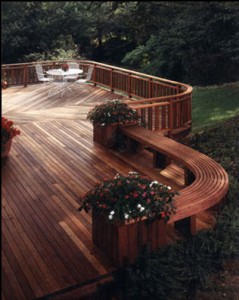
Decks can make great outdoor dining spaces
The main benefits of a deck are the elevation of the surface off the grounds and the relatively inexpensive materials. The drawbacks include the limited life of the wood materials used and the wear and tear on the surface. Unlike stone surfaces, the deck surface may need to be replaced eventually.
If you decide to go with a deck, we suggest staying away from natural wood decking because of the maintenance involved. Most wooden deck surfaces need to be treated annually and will still have a limited life span. Engineered materials do not need to be treated and will last for several years.
Pea stone and other aggregate stone materials
Crushed stone, pea stone or similar aggregate stone materials are probably the cheapest way to get a landscaping surface into your yard. The installation is easy, even for an inexperienced homeowner and the materials are inexpensive (with the exception of some exotic stone materials). It gives a very rustic look that fits well into casual designs. To install it, you just need to remove 5 or more inches of dirt from the area , lay down landscape fabric and then back fill it with the stone. You can create a patio in one day. If your patio area abuts a lawn, you may want to use some sort of edging between the stone area and the lawn.
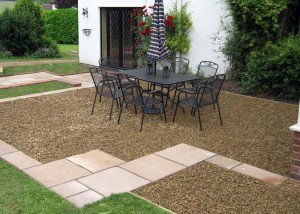
Pea stone makes a great low cost patio surface
The benefits of this material are in the rustic feel of the stone, the ease of installation and the low cost of the materials. However, there are several drawbacks to using pea stone. The stone tends to find its way into homes and can cause damage to interior floors. It is also prone to weeds that can grow through the stone (landscape fabric underneath will help, but not completely eliminate this problem). It’s also a little difficult to shovel snow or rake leaves off of this type of surface. Pea stone can be a great low cost surface for a rustic dining area, but make sure you’re willing to pull a few weeds if you want to use this material.
Pavers
Pavers are a great all around patio surface for dining areas. They come in a wide variety of shapes, sizes and colors. Pavers are more expensive than pea stone and most decking surfaces, but they last longer and give a more formal appearance. Pavers are difficult to install if you are inexperienced, but with some training it’s possible for a homeowner to install pavers successfully.
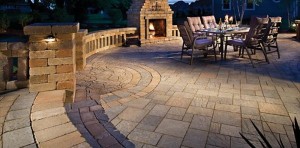
Pavers come in many shapes and sizes
The major benefit of pavers is the fine, smooth, finished look they give. The major drawbacks are the high cost and the possibility of weeds growing in gaps. Some homeowners also feel that pavers give an artificial look to outdoor surfaces. This really depends on the design and mood you are trying to create. Each year, better and more natural looking pavers are being created, so make sure you take a good look around before you make a decision. If you are installing pavers, we suggest using polymeric sand to fill in the spaces between pavers. Polymeric sand forms a tight bond when water is added that helps block weed growth.
Stamped Concrete
Stamped concrete can give the look (almost) of natural stone, but is much faster to install and does not leave room for weeds to grow between stones. It’s about the same price per square foot as pavers (depending on the paver you choose), but it’s much more flexible. You can create very natural looking or more formal looking designs by simply using different patterns.

Stamped concrete can look just like natural stone
Installation can only be done by professionals with the proper equipment. The major benefits are the flexibility of the style, the speed of install and the cost compared to natural stone. The only real drawbacks are the cost when compared to decks or pea stone and the possibility of cracking over time.
Natural stone
Natural stone is usually considered the most desirable of all patio surfaces. It’s hard to beat the beauty of natural stone. You can find stone to match almost any mood you’re trying to create. If you want your dining area to feel like it’s part of the landscape, then natural stone is your best choice. Unfortunately, it’s one of the most expensive surfaces to install. The major benefits of natural stone are it’s beauty and natural look. The drawbacks are primarily the high cost, weeds that may grow between stones and the shifting of stones that can happen over time creating uneven surfaces.
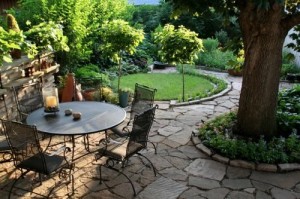
The look and feel of natural stone is hard to beat
Like pavers, natural stone is not easy to install if you have no experience, but with a little training (and a lot of sweat), it can be done by homeowners willing to put in the effort. If you are installing a natural stone patio, we suggest using polymeric sand to fill in the spaces between stones. As with pavers, this will help keep down weeds.
Once you’ve installed your dining area surface, you’ll be ready to add furniture and entertain! Just remember to stay true to your goal and the mood you’re trying to set when choosing furniture.
Good luck with your design and remember to enjoy it!









